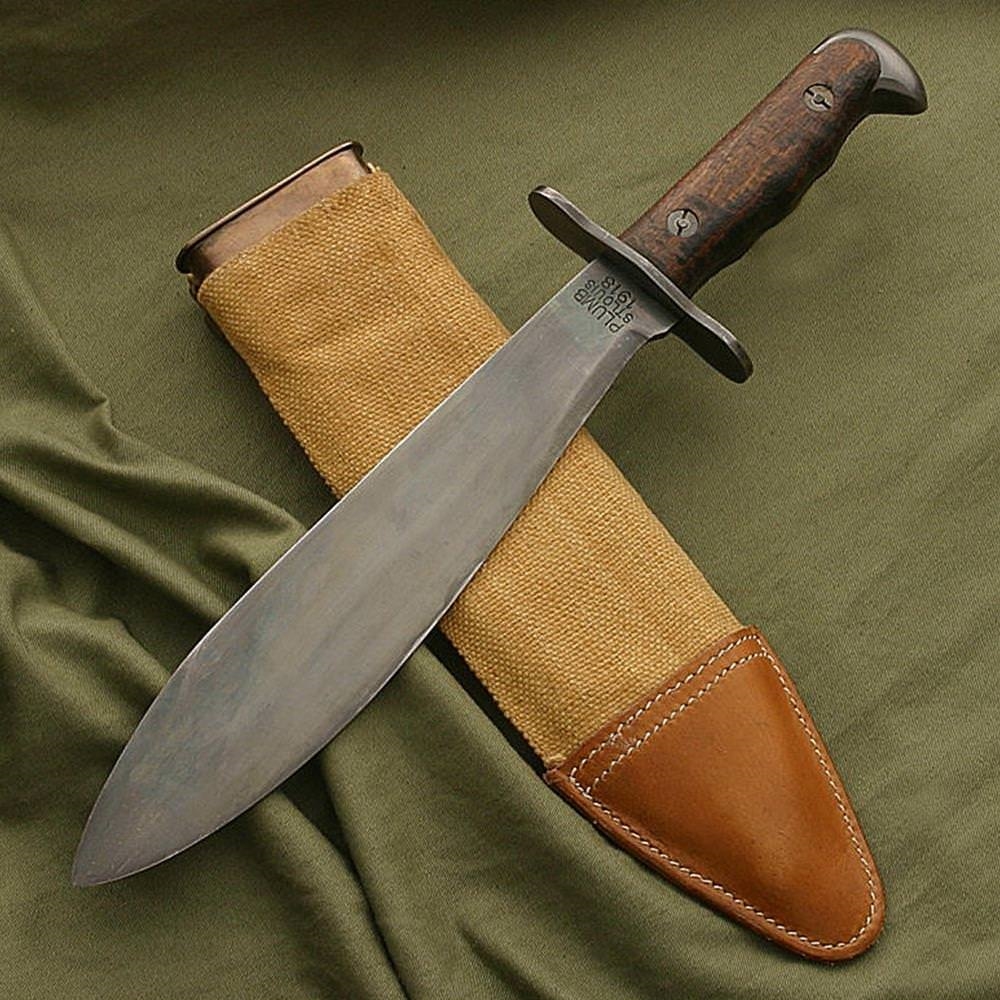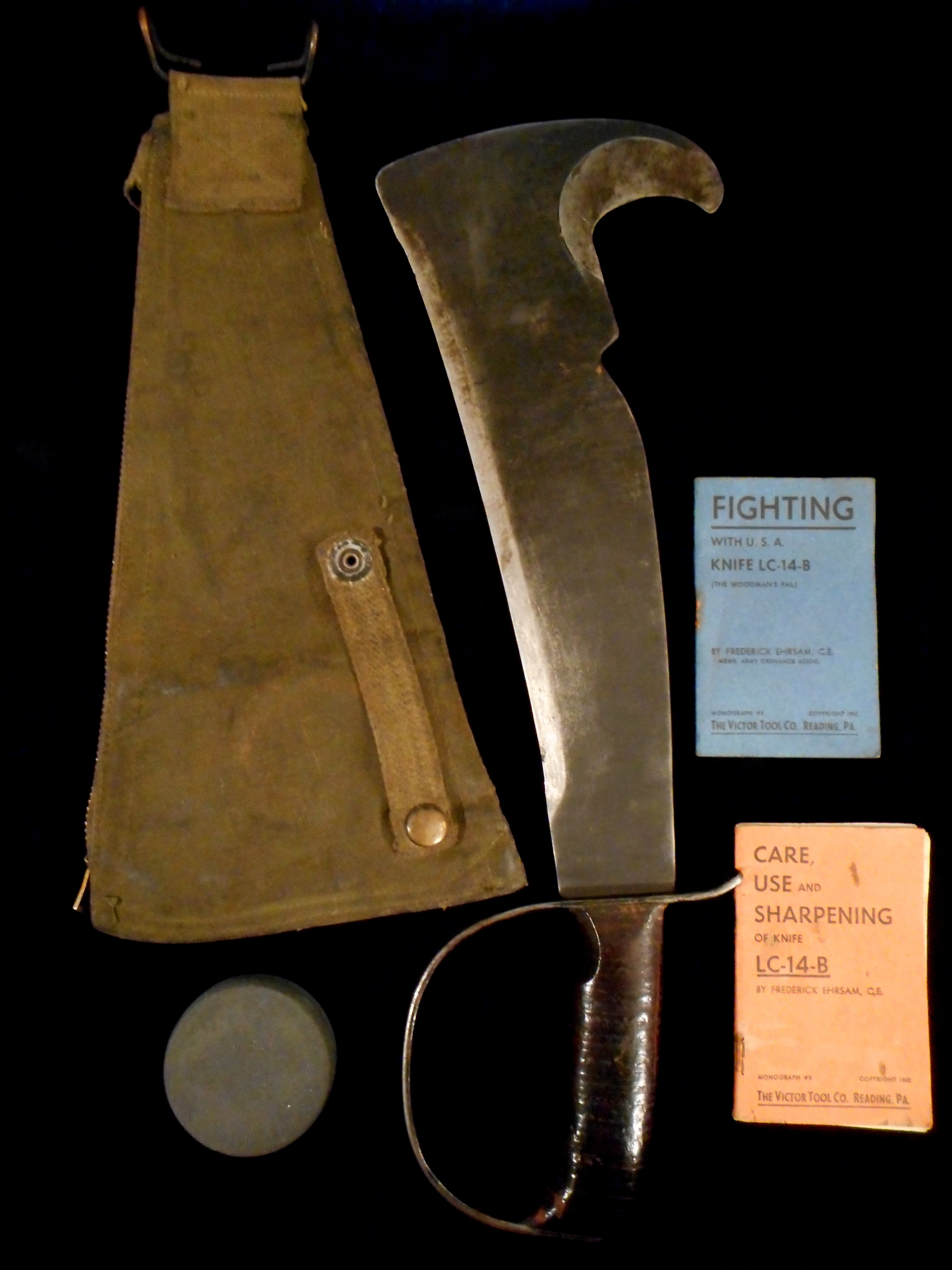Bolo Military - A bolo (Tagalog: iták/gúlok, Ilocano: bunéng, Ibanag: badáng/aliwa, Pangasinan: baráng, Kapampangan: paláng, Bikol: tabák/minasbad, Cebuano: súndang/kampilan, Waray: sansibar, Hiligaynon: sandúko/binangon, Aklan : talibong) is the general term for a small to medium-sized traditional pre-colonial single-edged sword or large Filipino knife that serves as a tool and weapon.
They are characterized by a broad curved blade that tapers towards the hilt, with a pointed or blunt end. The bolo is a common tool in the Philippines and is often confused with a machete.
Bolo Military

The bolo is distinguished from other Filipino swords and bladed tools by its dual use as a tool and weapon. They are characterized by a broad curved (usually convex) blade that tapers towards the hilt, with a pointed or blunt end. There are different types of bolo that differ by ethnic group and purpose, from large knives to cutlasses to specialized agricultural tools. Its uses are wide, from hunting to mowing grass, opening coconuts, harvesting crops or clearing bushes.
Afghan Commandos Listening To A Briefing For An Imminent Operation To Retake A Nearby Taliban Held Village, Base Near Farahrud Bazaar, Bolo Bluk District, Farah Province. Afghanistan's Elite Military Forces
Most bolos are cheap and unadorned, with handles usually made of horn or plain buffalo wood. A bolo with a finely carved handle made of precious material is used as a status symbol of a high social rank.
The bolo is common in the countryside because of its use as a farming tool. Because of this, it was widely used during the Spanish colonial rule as a manual alternative to buffalo plowing. Commonly used to cut coconuts,
It is also a common tool for harvesting a narrow range of crops found on terraces such as rice, green beans, soybeans, and peanuts.
During the American colonial period in the Philippines, Filipino warriors armed with truant were known as "boloms". They were used as auxiliary troops by the Americans during the Philippine-American War. They are often placed in front of the rifle, as confidence earrings.
Douglas B 18 Bolo
The Bolo m is effective in close combat with bayonet-wielding riflemen but is easily defeated if the rifle fires at them.
The Bolo was adopted by the US Military as the bolo knife. Manufactured from 1897 to 1918, they remained in service as a scrub clearer and for combat until World War II.
Bolo and related tools: (1) All-purpose Bolo; (2) Sabit haras or beyond; (3) Dagger knife; (4) small bolo; (5) Use; (6) Garab scythe; (7) Whitened sword; (8) The súndang or iták sword (also "tip bolo")

Different types of weapons are generally considered "truant" (c. 1926): (1) A Tagalog iták; (2) Tagalog Bolo; (3) Bagobo Sword; (4) Bolo Visayan (Cebu); (5) Barong Tausug; (6) Visayan (Cebu) purple sword; (7) Bagobo Sword; (8) Bagobo's sword; (9) Visayan súndang sword (Panay); (10) Yakan's silver sword
United States Army Issued Bolo Knife Stock Photo
Bolo is characterized by having a hard wooden handle or real animal horns (such as from buffalo),
Full tang, and a steel blade that bends and expands, usually so, toward the point.
This moves the gravity ctre as far forward as possible, providing an additional bolo of momentum to break.
The so-called "jungle truant", is for combat rather than farming work, to be longer and smaller at the end.
Bolo Knife And Scabbard
The term "bolo" has also been expanded to include other traditional blades that serve a primary or secondary function as agricultural tools. These include:
During World War I, United States Army soldier Henry Johnson gained international fame by repelling German attacks in hand-to-hand combat with a ball.
During World War II, members of the 1st Philippine Regiment and 81st Division used the bolo for close combat, earning them the special title "Moro Bolo Battalion".

On December 7, 1972, would-be assassin Carlito Dimahilig used a bolo to attack former First Lady Imelda Marcos while she was performing on stage at an award ceremony that was broadcast live on television. Dimahilig stabbed Marcos several times in the stomach, and he stopped the blow with his hand. He was shot dead by security forces while being taken to the hospital.
Pre World War I Bolo U.s. Military Knife/machete Manufactured By Springfield Armory, U.s.a. No
The bolo serves as a symbol of the Katipunan and the Philippine Revolution, particularly Pugad Lawin's Hiyaw. Some monuments to Andres Bonifacio, like other famous Katipuneros, depict him holding a bolo in one hand and the Katipunan flag in the other.
In the United States Military, the slang term "to bolo" - to fail a test, test, or examination, originates from the combined Filipino-American military forces including recognized guerrillas during the Spanish–American War and the Philippine–American War; Local soldiers and guerrillas who failed to show good marksmanship were given skipping instead of guns so as not to waste the scarce ammunition.
In sports of hand-to-hand combat, particularly boxing, the term "ball punch" is used to describe an uppercut that is thrown by mimicking the curved motion of the ball when used. We use technologies such as cookies to store and/or access device information. We do this to improve the browsing experience and show personalized ads. Consenting to this technology will allow us to process data such as browsing behavior or unique identifiers on these sites. Disagreeing or withdrawing consent, may affect certain features and functions.
Cookies are stored in your browser for the basic functionality of this web shop. For example the items you have in your shopping cart etc.
Spanish M1941 Mauser Bolo Bayonet, Scabbard
Storage or technical access is required for the legitimate purpose of storing preferences not requested by a customer or user.
Cookies are stored in your browser to collect anonymous statistical data. With these cookies, it is possible to see and analyze how people use this website as a large group and it is easier to direct improvements to problem points. Technical storage or access used exclusively for anonymous statistical purposes. Without a subpoena, voluntary compliance from your Internet Service Provider, or additional records from third parties, information stored or obtained for this purpose alone cannot generally be used to identify you.
Cookies are stored in your browser for marketing purposes. This means that you may see Irongate Armory added to some other websites, if these cookies are enabled.

Military discount, boingo wireless login military, mattress military discount, boingo wireless military, boingo military sign in, boingo discount code, boingo military login, boingo wifi military, boingo military sign up, verizon business military discount, verizon military discount, boingo military
0 Comments